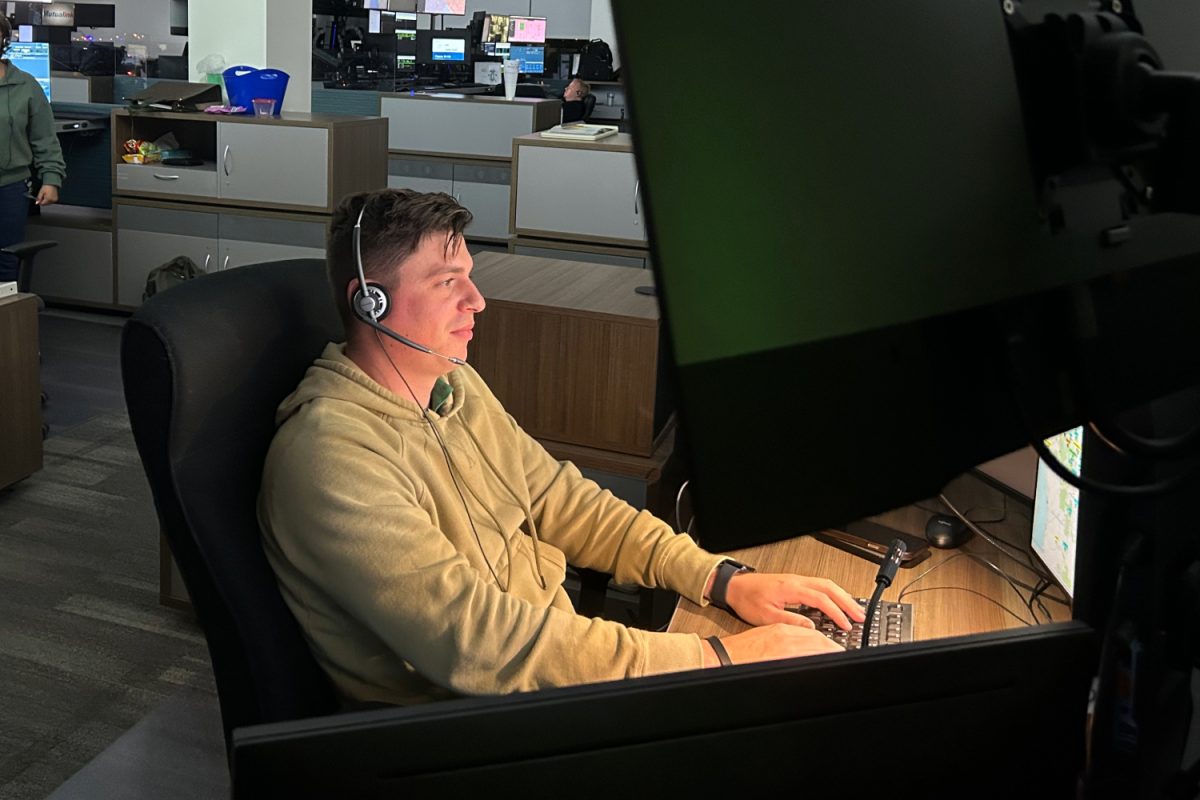The San Mateo County Dispatch Center receives 488,095 calls per year.
Each of these 911 calls is answered by one of the San Mateo County dispatchers, located on the second floor of the county’s Emergency Operations Center in Redwood City, California. Windows surround the center and there’s a slideshow of everyone’s pets in the corner, which brings a smile to everyone’s face, some lightness in a stressful workplace.
“The way I like to say it is we’re the first first responders because everything in law enforcement, everything in fire and paramedics, public safety, it starts with us,” said Natasha Claire-Espino, the Director of Public Safety Communications for San Mateo County.
Although these dispatchers dedicate countless hours to helping their community, they are stressed and understaffed, according to interviews and national surveys. Many dispatchers across America have suffered the mental strain of dealing with high-pressure situations every day.
How 911 operates
Each dispatcher sits at a desk looking at up to eight computer scenes. They wear a headset over one ear listening to calls while the other listens to what else is going on in the room.
Dispatchers seamlessly go from having conversations with one another to answering all types of calls: fires, medical emergencies, threats to people, or anything that requires first responders. While they’re ready for when the public needs them, these responsibilities come with a mental toll.
When receiving a call, the dispatchers focus on the four main Ws: who, what, where, and why. They have to make sure they get all of the information correct so they can send the best possible help. The most important of the Ws is the where. It helps immensely when the dispatchers know where the caller is so they can send help faster and more efficiently.
When calling 911, the first question the caller will be asked is “Do you need paramedics, fire or police?” If the caller responds with either fire or paramedics, they will be transferred to another dispatcher on the other side of the room. If the caller needs police, they will stay with the dispatcher, and they will help.
If they can’t get anyone there in time, the dispatchers instruct the caller what to do. Once the dispatcher receives all the critical information to the first responders, they ask a series of questions that come up on their computer. Depending on how they answer, those instructions will appear for the dispatcher to tell the caller.
“We get to give instructions for CPR or instructions on how to deliver a baby,” Claire-Espino said.
Mental Health
Alejandra Gonzalez, a dispatcher, described a call that highlights the mental stress of the job. The caller said someone had been shot in the head. Medical help was needed immediately. Gonzalez went through the W’s discovering the caller had shot themself in an attempt to take their life.
Being a dispatcher comes with many responsibilities and being held accountable when things go wrong. This is mentally draining.
According to a study by Carbyne and NENA: The 9-1-1 Association, 74% of dispatch centers report burnout among staff.
Over 90% of employers have support and wellness services, but only 18% use them. Dispatchers could have the worst call of your life and then have to go on and continue your job. San Mateo County offers many resources and options to help their workers.
“We have established a well-being committee… we want to create a remarkable experience for employees and for those we serve,” Claire-Espino said.
They also provide therapy and other resources for the dispatchers. In addition to the well-being committee, many dispatchers have hobbies and other things they do outside of work to cope with what they hear at work.
“If you go home and all you do is talk about medical work or firefighter work or law enforcement. You can’t really escape it. So I think it’s important to have outlets that have nothing to do with this line,” said Ashley Sutton, a shift supervisor.
Many of the dispatchers have either kids or other things to do that help them deal with what they hear at work. Sharing photos on a communal slideshow helps take the edge off the moment-to-moment stress, dispatchers said.
How to Become a Dispatcher
The training to become a 911 dispatcher for San Mateo County entails a 12-week process. The requirements are having a high school diploma and being over 18 years old. After applying, a person will have a background check that closely resembles the one for police officers.
In San Mateo County, there are a lot of different types of learning that goes into being a dispatcher. There is classroom training, hands-on training, and also sitting alongside a mentor who walks trainees through how to answer the phone and what to say in different situations.
Trainees then learn how to operate the radio, which is taught in an academy setting. Once that is complete, soon-to-be official dispatchers will be out on the floor answering calls.
“You want to have the desire to help others,” Claire-Espino said.
To be a dispatcher, applicants need to have a specific set of skills and be able to separate work from home life. The key is to be able to deal with high-stress situations.
They are looking for people with experience in a “fast-paced environment with frequently changing priorities,” according to the SMC website.
At San Mateo County the pay ranges from $83,636.80 to $93,475.20 annually for starting dispatchers.
The county’s website has a 1,382-word job description, but one dispatcher, Dominic Sabel, summed it up in only 15.
“We just sit around. Wait for the phone to ring. Try to save some lives.”













